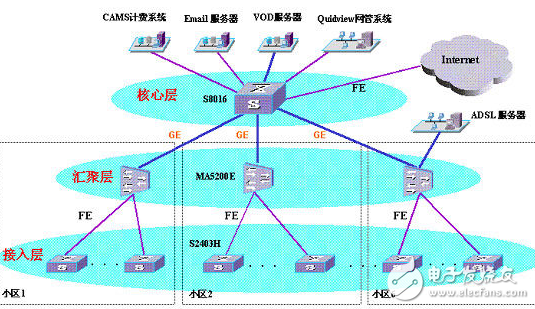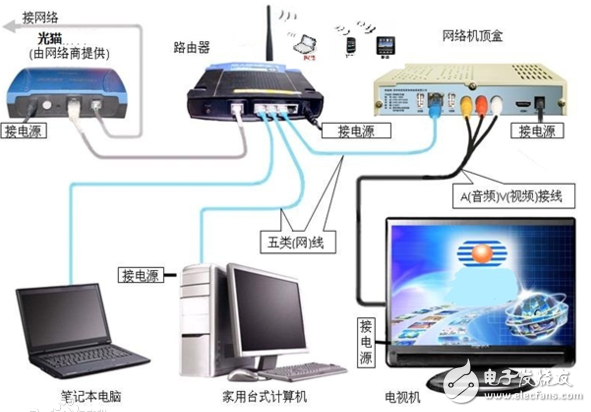A fiber optic network is a light-conducting tool that uses the principle of total reflection of light in fibers made of glass or plastic to be connected to a company or home or computer room. Use a switch or other terminal to convert to a normal RJ45 network cable and connect it to the computer, also called LAN. The switch or other terminal automatically assigns IP. The internal network IP needs to be set in the background of the terminal. The default is automatic, no dialing.
The width of the frequency band represents the size of the transmission capacity. The higher the frequency of the carrier, the greater the bandwidth of the signal that can be transmitted. In the VHF band, the carrier frequency is 48.5 MHz to 300 Mhz. With a bandwidth of about 250MHz, it can only transmit 27 sets of TVs and dozens of FM radios. The frequency of visible light reaches 100,000 GHz, which is more than one million times higher than the VHF band. Although the bandwidth is affected by the different losses of the fibers to different frequencies of light, the bandwidth in the lowest loss region can reach 30,000 GHz. The bandwidth of a single light source only accounts for a small part of it (multi-mode fiber has a frequency band of several hundred megahertz, good single-mode fiber can reach more than 10 GHz), and advanced coherent optical communication can arrange 2000 optical carriers in the range of 30000 GHz. , for wavelength division multiplexing, can accommodate millions of channels.

Broadband networks generally refer to networks with bandwidths above 155 kbps. Corresponding to the broadband network is a narrowband network. Broadband networks can be divided into two parts: broadband backbone network and broadband access network.
Broadband networks can be divided into two parts: broadband backbone network and broadband access network.
(1) The backbone network, also known as the core switching network, is based on a fiber-optic communication system and can realize a wide range of data stream transmission. The telecommunications industry generally believes that the backbone network with a transmission rate of 2 Gbps is called a broadband network.
(2) Access network technology can be divided into fiber access, copper access, fiber coaxial cable hybrid access and wireless access according to the different transmission media used.

1. Up and down
ADSL (Asymmetric Digital Subscriber Loop) technology is a technology for implementing broadband access to the Internet through an asymmetric digital subscriber line. As a transmission layer technology, ADSL makes full use of existing copper resources to provide on a pair of twisted pairs. Upstream 640 kbps (the theoretical uplink 1 Mbps) downlink 8 Mbps bandwidth, thus overcoming the "bottleneck" of the traditional user in the "last mile", realizing the true sense of broadband access.
The uplink rate generally refers to the speed of uploading from your computer, that is, the rate at which others communicate from your computer.
The downstream rate is generally the speed at which you download from the host on the network.
Generally, the uplink and downlink rates of the ADSL Internet access mode are asymmetric, and the downlink rate is generally high and the uplink is relatively low. Now the general is the uplink: 386Kb, downlink: 512Kb.
Note that the speed is different from the actual speed. Generally, it needs to be divided by 8, so the actual speed is only about 50K.
The optical fiber uses a two-core optical cable, one core is uplinked, and one core is downlink for data transmission.
First, it is a passive network. From the central office to the user, it can basically be passive. Secondly, its bandwidth is a relatively wide FTTH, and the long distance is in line with the large-scale operation mode of the operator; Because it is a service carried on fiber, so there is no problem; Fourth, because of its wide bandwidth, the supported protocols are more flexible; Fifth, with the development of technology, including point-to-point, 1.25G and FTTH The way has been developed with relatively complete features.
2, route jump
In optical fiber transmission, there are fewer intermediate devices and fewer hops, so the probability of occurrence of the problem is relatively lower, and the transmission speed with the backbone network is faster. At the same time, the bandwidth of optical fiber is much higher than that of ADSL.
3, technical comparison
(1) Analysis from the perspective of technological development
ADSL is a good transition technology, FTTX+LAN is a better technology than ADSL, and it is a true broadband technology.
(2) Applicable population comparison
ADSL is suitable for distributed users, and FTTH+LAN is targeted at a relatively concentrated user community.
(3) Popularization and consumer cognition
ADSL is currently a popular product in the broadband market and is widely recognized by the public. Most consumers are increasingly aware of LAN awareness and expectations.
(4) Cost and price comparison
The advantage of fiber-optic broadband is that the cost of networking equipment such as hubs and Ethernet switches is low, and users do not need to install an ADSL modem. This is the capital of Ethernet and ADSL competition. Fiber broadband users have less investment and cheaper prices. ADSL utilizes the existing telephone network of the city's telephone network and telephone exchange, and cannot be separated from the fixed telephone. It is subject to geographical restrictions, and the cost of the telephone also increases the cost of the product.
(5) speed comparison
Due to the asymmetric digital technology of ADSL technology, the speed is up and down asymmetric, the network speed is limited, and the maximum network speed is 8M. Therefore, ADSL cannot meet the demand for access rate in the future market. The LAN adopts symmetric digital broadband technology, has a wider frequency band, and has variable bandwidth, which can continuously increase the speed. The network speed can be greater than 8M or even more than 150M.
(6) Stability and anti-interference
ADSL has a general quality requirement for the line. When the line quality is not good, it will affect the stability. When the transmission rate is higher, the influence of attenuation and crosstalk on the signal is larger, and sometimes the problem of network rate drop and dropped line occurs.
The FTTX community broadband adopts different networks from the telephone network, and the corridor switch and the cell center switch, the cell center switch and the central office switch are connected by optical fibers, and the network has high stability and high reliability, and it is not possible to have mutual influence problems. .
(7) Access method
FTTX+LAN is fiber to the building
The network cable is connected to the household, and the ADSL is an ordinary telephone twisted pair. The access of LAN users is simpler. Routers, switches, and even ordinary network cards can be used for access. The user end uses five types of network lines to access, plug and play. At the same time, because the LAN method uses the optical cable + five types of lines to comprehensively route the community, the line quality is better guaranteed.
(8) Comparison of business and function
ADSL can support Internet/Extranet/Intranet services, voice services, video services, ATM services, data services, frame relay FR access services, and VPN virtual private network services, enabling inter-network interconnection, information sharing, mutual access, and delivery.
The FTTX+LAN method covers all ADSL all services and functions on the basis of existing ADSL. FTTX+LAN helps to establish an intelligent community broadband network system, and integrates the home terminal and the property management platform into an overall local area network to support various online value-added services for property management.
Shenzhen Aierbaita Technology Co., Ltd. , https://www.aierbaitavape.com
